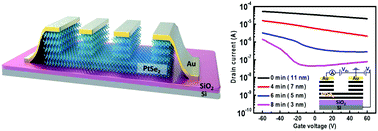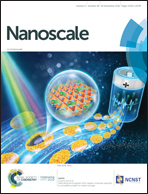Homogeneous platinum diselenide metal/semiconductor coplanar structure fabricated by selective thickness control†
Abstract
For the realization of two-dimensional material-based high-performance electronic devices, the formation of a stable, high-quality metal–semiconductor contact is a key factor. Platinum diselenide (PtSe2), a group-10 transition metal dichalcogenide, is a promising candidate owing to its unique property of layer-dependent semiconductor-to-semimetal transition. Here, a scalable and controllable method utilizing an inductively coupled plasma treatment is reported for selectively controlling the thickness of PtSe2 flakes. The PtSe2 transforms from a semimetal to a semiconductor when the thickness decreases below 3 nm. A field-effect transistor is fabricated based on the homogeneous platinum diselenide metal/semiconductor coplanar structure (metallic PtSe2 as source/drain electrodes and semiconductor PtSe2 as a channel), which demonstrates a low contact resistance of 362 Ω μm and carrier mobility of 150 cm2 V−1 s−1, outperforming the previously reported PtSe2-based devices.



 Please wait while we load your content...
Please wait while we load your content...